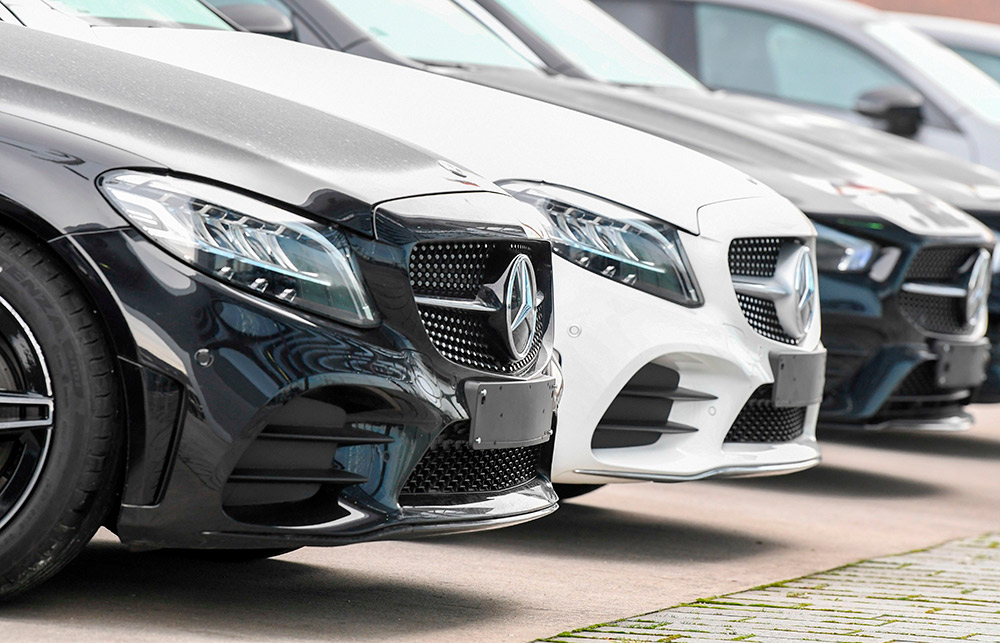
得益于以中國為首的全球汽車市場的良好環(huán)境,,戴姆勒公司(Daimler AG)第一季度收益輕松超過分析師預(yù)期,。這或?qū)⒁馕吨摴镜谝患径蓉攬蟊憩F(xiàn)喜人,。
戴姆勒公司所有業(yè)務(wù)領(lǐng)域的盈利能力都表現(xiàn)優(yōu)異,,核心的輕型車輛部門的表現(xiàn)尤其振奮人心——輕型車輛部門的業(yè)績本來受到了去年緊急成本削減的影響(價格上浮),,但需求仍不斷上升,,業(yè)績得到提振。
“在一個令人鼓舞的市場環(huán)境中,,我們在繼續(xù)實現(xiàn)我們的野心,?!惫臼紫瘓?zhí)行官Ola K?llenius在一份聲明中表示,,“降低公司盈虧平衡點的系統(tǒng)性舉措,成效正越來越凸顯,?!?/p>
根據(jù)未經(jīng)審計的公司數(shù)據(jù),該公司當(dāng)季綜合營業(yè)利潤飆升至57億歐元(68億美元)以上,。
這一數(shù)字超過了50億歐元(60億美元)的普遍預(yù)期,,遠遠超過了一年前的6.17億歐元(7.4億美元)。一年前,戴姆勒公司的中國業(yè)務(wù)正受到疫情的壓力,。
戴姆勒將強勁的業(yè)績歸功于三個市場變量,,當(dāng)然,這三個變量也將使其他高端競爭對手受益:更高的銷量,、更高的定價和更能盈利的銷售組合,。對寶馬(BMW)和保時捷(Porsche)等其它汽車制造商來說,強勁的業(yè)績意味著利好——4月16日,,這兩家汽車制造商的汽車銷量實現(xiàn)大幅增長,。
戴姆勒旗下高端品牌梅賽德斯-奔馳(Mercedes-Benz)當(dāng)季銷量實現(xiàn)兩位數(shù)增長。與此同時,,其國內(nèi)競爭對手寶馬的汽車銷量也創(chuàng)下紀(jì)錄,。
轎車和貨車是梅賽德斯-奔馳收入的主要來源,調(diào)整后的營業(yè)利潤率為14.3%,,使其躋身保時捷等豪華品牌之列,。分析師此前的利潤率預(yù)期為11.7%,高于該公司自己8%-10%的預(yù)期區(qū)間,。
Jefferies的股票分析師在一份研究報告中稱,,"盡管該行業(yè)第二季度的生產(chǎn)環(huán)境看起來困難重重,但此次反彈或?qū)?dǎo)致該公司評級上調(diào),。"Jefferies將該股評級為"買入",,目標(biāo)股價為95歐元。
戴姆勒的財務(wù)狀況也有所恢復(fù),,整個業(yè)務(wù)的凈資產(chǎn)變現(xiàn)能力增至201億歐元(241億美元),,幾乎是2019年底,新冠疫情大規(guī)模爆發(fā)前的兩倍,。
剔除4.16億歐元(約合4.99億美元)的重組費用和7500萬歐元(約合9000萬美元)的法律風(fēng)險損失外,,該公司的季度業(yè)績包括12億歐元(約合14億美元)的一次性收益。這一收益的達成,,與該公司將燃料電池資產(chǎn)剝離至與商用車制造商沃爾沃集團(Volvo Group)共同運營的新合資企業(yè)有關(guān),。
4月16日,該公司早盤股價上漲2.7%,,至77.39歐元,。今年迄今,該公司股價已上漲三分之一,,超過了斯托克歐洲汽車指數(shù)(STOXX Europe automobiles index)23%的漲幅,。
戴姆勒今年2月宣布,該公司將分拆為兩家純業(yè)務(wù)公司,,以抵消長期以來令其股價受損的企業(yè)集團折價,。
第一個公司將集中在豪華乘用車業(yè)務(wù)上,。目前,該公司正忙著推出梅賽德斯EQS等新型電動汽車,。而另一個公司將專注于重型卡車和公共汽車,,如長途汽車Actros semi。
另外,,大眾汽車集團(Volkswagen Group)旗下保時捷品牌公布的季度銷量顯示,,零售額增長了36%,這主要得益于中國和美國買家搶購其受歡迎的豪華SUV卡宴(Cayenne)和邁凱(Macan),。該公司首款純電動汽車泰坎(Taycan)運動轎車的銷量從去年同期剛上市時的1391輛躍升至9072輛,。
相比之下,在持續(xù)封鎖的情況下,,歐洲汽車市場依然舉步維艱,。4月16日,歐洲汽車行業(yè)報告稱,,3月份汽車需求出現(xiàn)反彈——而這在很大程度上“得益于”前一年的巨幅疲軟,。盡管需求有所反彈,也僅能夠抵消今年開局不佳的影響,。包括英國在內(nèi),,歐洲第一季度新車銷量基本持平,為308萬輛,。(財富中文網(wǎng))
編譯:楊二一
得益于以中國為首的全球汽車市場的良好環(huán)境,,戴姆勒公司(Daimler AG)第一季度收益輕松超過分析師預(yù)期。這或?qū)⒁馕吨?,該公司第一季度財報表現(xiàn)喜人,。
戴姆勒公司所有業(yè)務(wù)領(lǐng)域的盈利能力都表現(xiàn)優(yōu)異,核心的輕型車輛部門的表現(xiàn)尤其振奮人心——輕型車輛部門的業(yè)績本來受到了去年緊急成本削減的影響(價格上?。?,但需求仍不斷上升,業(yè)績得到提振,。
“在一個令人鼓舞的市場環(huán)境中,,我們在繼續(xù)實現(xiàn)我們的野心?!惫臼紫瘓?zhí)行官Ola K?llenius在一份聲明中表示,,“降低公司盈虧平衡點的系統(tǒng)性舉措,成效正越來越凸顯,?!?/p>
根據(jù)未經(jīng)審計的公司數(shù)據(jù),,該公司當(dāng)季綜合營業(yè)利潤飆升至57億歐元(68億美元)以上,。
這一數(shù)字超過了50億歐元(60億美元)的普遍預(yù)期,,遠遠超過了一年前的6.17億歐元(7.4億美元)。一年前,,戴姆勒公司的中國業(yè)務(wù)正受到疫情的壓力,。
戴姆勒將強勁的業(yè)績歸功于三個市場變量,當(dāng)然,,這三個變量也將使其他高端競爭對手受益:更高的銷量,、更高的定價和更能盈利的銷售組合。對寶馬(BMW)和保時捷(Porsche)等其它汽車制造商來說,,強勁的業(yè)績意味著利好——4月16日,,這兩家汽車制造商的汽車銷量實現(xiàn)大幅增長。
戴姆勒旗下高端品牌梅賽德斯-奔馳(Mercedes-Benz)當(dāng)季銷量實現(xiàn)兩位數(shù)增長,。與此同時,,其國內(nèi)競爭對手寶馬的汽車銷量也創(chuàng)下紀(jì)錄。
轎車和貨車是梅賽德斯-奔馳收入的主要來源,,調(diào)整后的營業(yè)利潤率為14.3%,,使其躋身保時捷等豪華品牌之列。分析師此前的利潤率預(yù)期為11.7%,,高于該公司自己8%-10%的預(yù)期區(qū)間,。
Jefferies的股票分析師在一份研究報告中稱,"盡管該行業(yè)第二季度的生產(chǎn)環(huán)境看起來困難重重,,但此次反彈或?qū)?dǎo)致該公司評級上調(diào),。"Jefferies將該股評級為"買入",目標(biāo)股價為95歐元,。
戴姆勒的財務(wù)狀況也有所恢復(fù),,整個業(yè)務(wù)的凈資產(chǎn)變現(xiàn)能力增至201億歐元(241億美元),幾乎是2019年底,,新冠疫情大規(guī)模爆發(fā)前的兩倍,。
剔除4.16億歐元(約合4.99億美元)的重組費用和7500萬歐元(約合9000萬美元)的法律風(fēng)險損失外,該公司的季度業(yè)績包括12億歐元(約合14億美元)的一次性收益,。這一收益的達成,,與該公司將燃料電池資產(chǎn)剝離至與商用車制造商沃爾沃集團(Volvo Group)共同運營的新合資企業(yè)有關(guān)。
4月16日,,該公司早盤股價上漲2.7%,,至77.39歐元。今年迄今,,該公司股價已上漲三分之一,,超過了斯托克歐洲汽車指數(shù)(STOXX Europe automobiles index)23%的漲幅。
戴姆勒今年2月宣布,,該公司將分拆為兩家純業(yè)務(wù)公司,,以抵消長期以來令其股價受損的企業(yè)集團折價,。
第一個公司將集中在豪華乘用車業(yè)務(wù)上。目前,,該公司正忙著推出梅賽德斯EQS等新型電動汽車,。而另一個公司將專注于重型卡車和公共汽車,如長途汽車Actros semi,。
另外,,大眾汽車集團(Volkswagen Group)旗下保時捷品牌公布的季度銷量顯示,零售額增長了36%,,這主要得益于中國和美國買家搶購其受歡迎的豪華SUV卡宴(Cayenne)和邁凱(Macan),。該公司首款純電動汽車泰坎(Taycan)運動轎車的銷量從去年同期剛上市時的1391輛躍升至9072輛。
相比之下,,在持續(xù)封鎖的情況下,,歐洲汽車市場依然舉步維艱。4月16日,,歐洲汽車行業(yè)報告稱,,3月份汽車需求出現(xiàn)反彈——而這在很大程度上“得益于”前一年的巨幅疲軟。盡管需求有所反彈,,也僅能夠抵消今年開局不佳的影響,。包括英國在內(nèi),歐洲第一季度新車銷量基本持平,,為308萬輛,。(財富中文網(wǎng))
編譯:楊二一
Daimler AG’s first-quarter earnings easily surpassed analyst expectations on the back of favorable conditions in global car markets led by China, suggesting a strong reporting season for Germany’s carmakers.
Profitability was strong in all areas of its business, but particularly impressive at its core light-vehicles division, where a rising tide of demand lifted results already buoyed by emergency cost cutting from last year.
“We continue to execute on our ambitions in a very encouraging market environment,” said chief executive Ola K?llenius in a statement. “Our systematic efforts to lower the break-even point of the company are becoming increasingly visible.”
Consolidated operating profit at the group soared to over 5.7 billion euros ($6.8 billion) in the quarter, according to unaudited company figures.
This beat consensus estimates of 5 billion euros ($6 billion) and far surpassed the 617 million euros ($740 million) recorded a year ago, when the pandemic was already weighing on its key Chinese business.
Daimler attributed the strong results to three market variables that would also benefit other premium competitors: higher volumes, stronger pricing, and a more lucrative sales mix. The implications of the robust earnings are bullish for other carmakers such as BMW and Porsche, which posted a sharp gain in car sales on Friday.
Daimler’s premium brand Mercedes-Benz posted double-digit gains in volume for the quarter, a period in which domestic rival BMW enjoyed record vehicle sales.
Mercedes-Benz cars and vans contributed the bulk of its earnings, delivering an adjusted operating margin of 14.3% that pushed it into the lofty realms of a luxury brand like Porsche. Analysts had expected a strong 11.7% by comparison, above the company’s own 8% to 10% range.
“The magnitude of the beat will likely lead to upgrades despite what looks like a challenging production environment for the industry in Q2,” equity analysts at Jefferies said in a research note, which rates the stock a “buy” with a 95-euro price target.
Daimler’s finances also recovered with net liquidity across its industrial operations rising to 20.1 billion euros ($24.1 billion), nearly twice as high as at the end of 2019, prior to the mass outbreak of COVID-19.
Apart from 416 million euros ($499 million) in restructuring charges and another 75 million euro ($90 million) hit from legal risks, quarterly results included 1.2 billion euros ($1.4 billion) in one-off gains related to the carve-out of its fuel cell assets into a new joint venture operated together with commercial vehicle manufacturer Volvo Group.
Shares were up 2.7% at 77.39 euros in early Friday trading and have gained a third in value year to date, outpacing the 23% increase in the broader STOXX Europe autos index.
In an attempt to neutralize the conglomerate discount that had long weighed on its stock, Daimler announced in February it would split itself up into two pure-play companies.
The first would center on its premium passenger car operations, which are busy rolling out new electric vehicles such as the Mercedes EQS. The other would focus on heavy-duty trucks and buses like the long-haul Actros semi.
Separately, Volkswagen Group’s Porsche brand published quarterly volumes that saw a 36% jump in retail sales, thanks mainly to Chinese and American buyers snapping up its popular Cayenne and Macan luxury SUVs. Its first-ever battery electric vehicle, the Taycan sports sedan, saw unit sales jump to 9,072 from 1,391 in the corresponding quarter of the previous year when it had just hit markets.
By comparison the European car market continues to struggle as lockdowns continue. The region’s auto industry reported on Friday a rebound in demand in March that was flattered heavily by a historically weak month in the previous year. Nonetheless it was just enough to offset the year’s poor start, leaving first-quarter volumes largely flat with 3.08 million new cars sold, including in the U.K.






